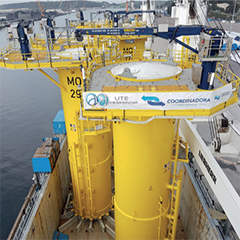Words: Ignacio Serrada and Alfonso Hernández, members of Offshore and Modular Department
By the end of October, the first shipment of transition pieces (TP) for the MERKUR offshore wind project had been completed. The brief was to take full responsibility for organising the transportation and associated engineering, to ship these components from the manufacturer’s premises to the hub port for the transfer of TPs to the installation vessel. COORDINADORA, in charge of the engineered transportation, is thrilled to share this stunning case study exclusively with PES.
The challenge came from an established customer IDESA-WINDAR, the joint company in the DANIEL ALONSO Group, they were awarded the order to manufacturer 66 transition pieces for the Merkur Project. They were manufactured in their Aviles facilities and had to be delivered to GeoSea, part of the DEME Group, in Eemshaven Port who was the main contractor.
The first task was to select the most suitable vessel to match the obvious competitive requirements and the technical reliability needed to carry this crucial cargo, especially with regards to the lifting capacity of ship’s cranes.
Thus, COORDINADORA, an expert in the shipping sector for over 35 years, prepared a particular RFQ for the ship owners to bid for the necessary consecutive shipments along the same route.
Time has demonstrated the importance of experience in handling such a complicated negotiation, resulting in full-warranty vessel features, for several consecutive shipments. It was done by matching the client needs, not only in terms of technical solvency, but also the flexibility to integrate into the manufacturing schedule.
Once the vessel selection process was completed in favour of the top category company Rolldock Shipping, a joint team headed by COORDINADORA’s in-house engineers started the to design the grillage and sea fastening solution, which is the key factor in the transportation of these particular type of cargo.
Transition pieces are in concept vertical cylinders, almost 30m high and about 6.5m diameter weighing 330mt. The cargo footprint is only a narrow ring for transmitting the whole load. That is the reason why it is necessary to employ load spreaders on the vessel deck to distribute the weight and inertia forces efficiently along the ship’s own structure, within allowable threshold values.
The only permissible area where it is possible to connect any securing element on this cargo is at the bottom flange in contact with the load spreaders. Therefore, the mechanical seafastening solution has to be applied to the same load-spreading structures.



























